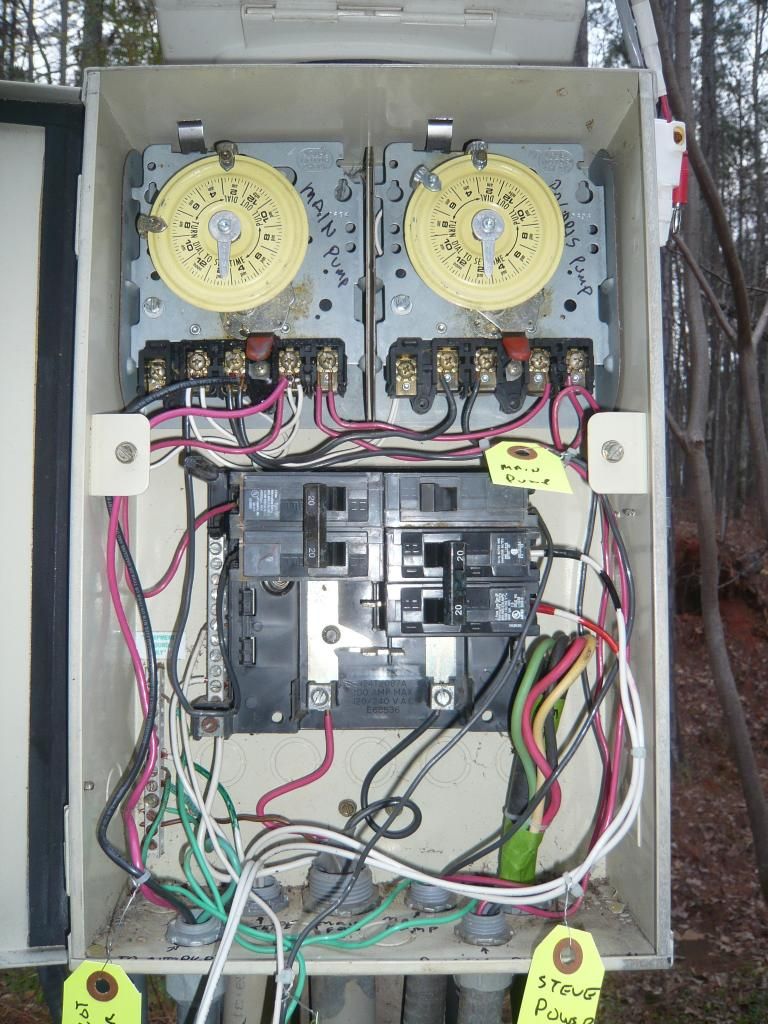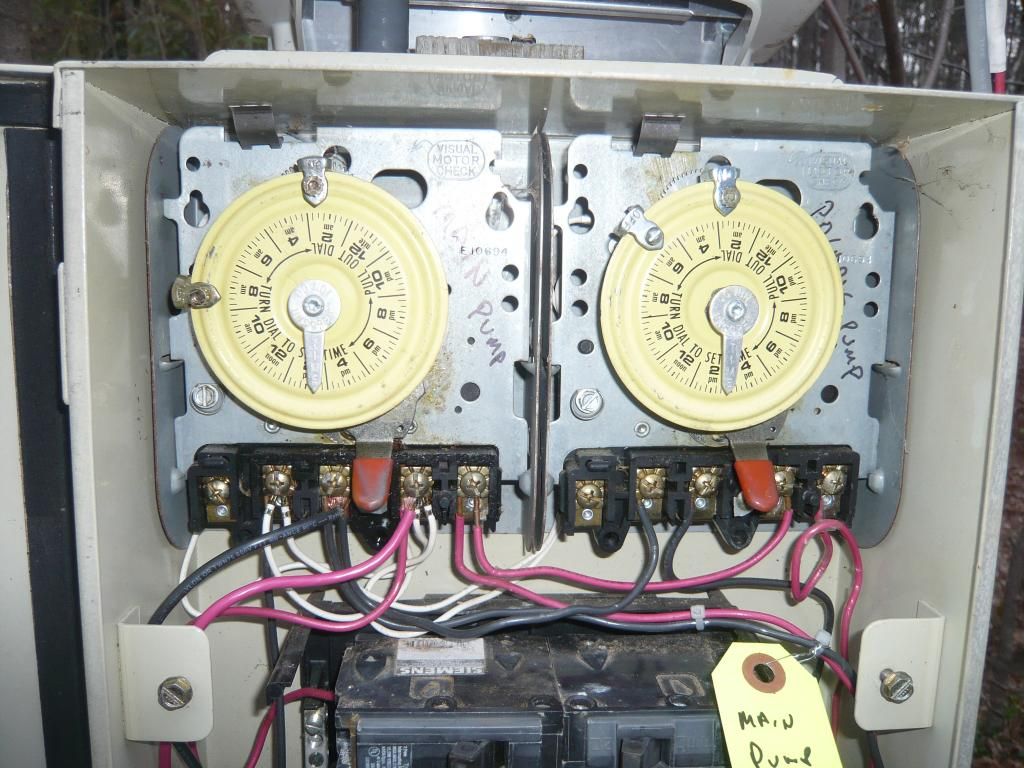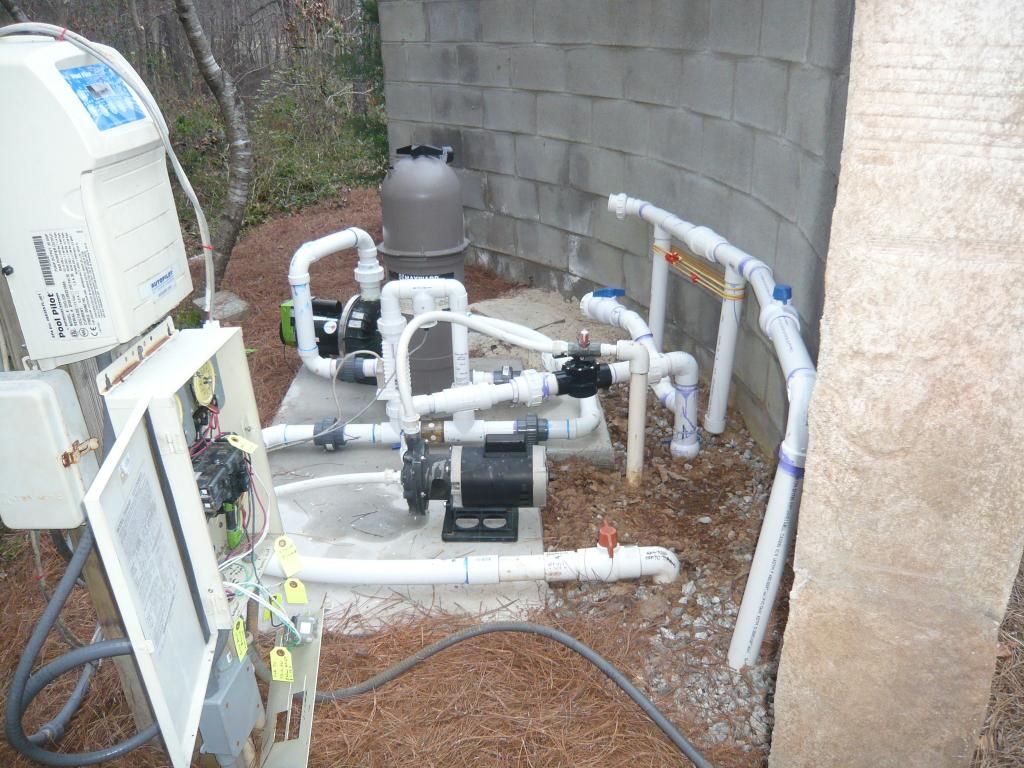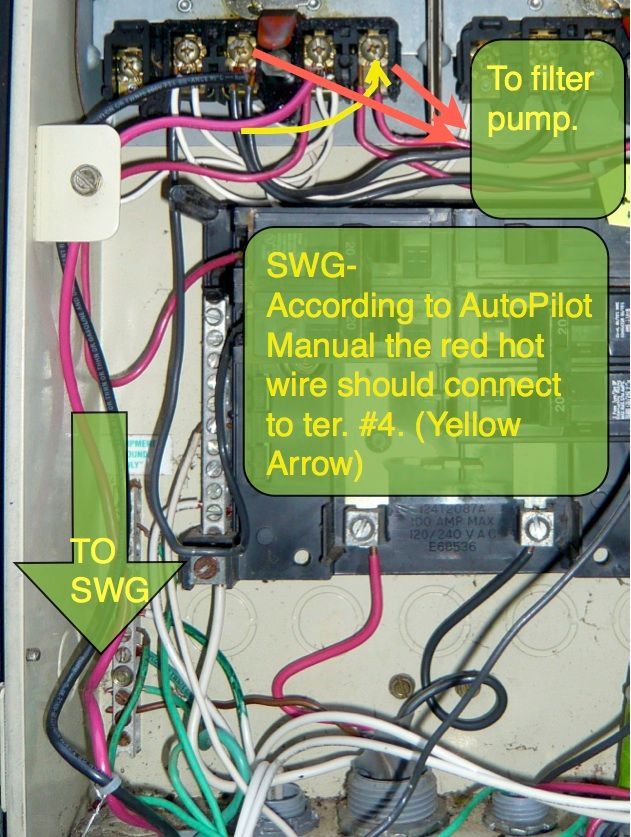Wiring check
- Thread starter scratchedup
- Start date
You are using an out of date browser. It may not display this or other websites correctly.
You should upgrade or use an alternative browser.
You should upgrade or use an alternative browser.
What size breaker feeds that box from the main panel? I am a bit curious about the abandoned cable in the lower right hand side. That looks like it may have been the original feed based on the wire size. The wire feeding it now looks to be a bit small.
Not real sure what the smaller white wires are doing on the terminals of the left hand timer. Kind of hard to trace them. It may be they are the power feeds to the timer motors.
I am a bit concerned about what type of wire was used coming in and out of the box. My concern comes from the fact that two white wires were repurposed as hot leads. The way they are used is to code as they are marked. I am more concerned that they most likely come from romex type cable. If this is the case it must be rated for direct burial (uf-b)even if it is in pipe as NM is not rated for wet locations.
What do the wires go to that hang out of the front of the box?
As far as everything else, It looks pretty good. A little sloppier than I would like, but still functional.
Not real sure what the smaller white wires are doing on the terminals of the left hand timer. Kind of hard to trace them. It may be they are the power feeds to the timer motors.
I am a bit concerned about what type of wire was used coming in and out of the box. My concern comes from the fact that two white wires were repurposed as hot leads. The way they are used is to code as they are marked. I am more concerned that they most likely come from romex type cable. If this is the case it must be rated for direct burial (uf-b)even if it is in pipe as NM is not rated for wet locations.
What do the wires go to that hang out of the front of the box?
As far as everything else, It looks pretty good. A little sloppier than I would like, but still functional.
What size breaker feeds that box from the main panel?
I will have to check when I get home tomorrow.
I am a bit curious about the abandoned cable in the lower right hand side.
I did this temporarily just to work on the system and ID the wires and clean it up. It is a freeze guard.
That looks like it may have been the original feed based on the wire size. The wire feeding it now looks to be a bit small.
Not real sure what the smaller white wires are doing on the terminals of the left hand timer. Kind of hard to trace them. It may be they are the power feeds to the timer motors.
I am a bit concerned about what type of wire was used coming in and out of the box. My concern comes from the fact that two white wires were repurposed as hot leads. The way they are used is to code as they are marked. I am more concerned that they most likely come from romex type cable. If this is the case it must be rated for direct burial (uf-b)even if it is in pipe as NM is not rated for wet locations.
not sure here... prob is not up to code...I know the white wires are in conduit.
What do the wires go to that hang out of the front of the box?...To a water feature
As far as everything else, It looks pretty good. A little sloppier than I would like, but still functional.
This is a work in progress....and it is now a DIY because of this..."A little sloppier than I would like"....me to.
Pretty sick/tired of all the crappy work that I have paid for over the years.
Thanks for the help.
Your drawing looks fine. But in the picture I see a pair of red and black wires that are not in the drawing that are hooked to the timer on the left. Looks like the Red is always powered from one leg and the Black is powered from the other leg when the switch is on.
Ideally you would have the pump supplied by a GFCI breaker, but with those added wires going to different loads (?) that could cause an imbalance and trigger a GFCI.
Is there a GFCI somewhere on the light circuit at least???? I have my light circuit feed a GFCI outlet and then off the protected side of the outlet to my light ... maybe yours is the same?
Ideally you would have the pump supplied by a GFCI breaker, but with those added wires going to different loads (?) that could cause an imbalance and trigger a GFCI.
Is there a GFCI somewhere on the light circuit at least???? I have my light circuit feed a GFCI outlet and then off the protected side of the outlet to my light ... maybe yours is the same?
I don't think your drawing is correct although I suspect, in wire, it is correct.
The hot feed wires, black and red in the drawing actually go up to the dual 20A circuit breaker at the left. The black wire feeds 1/2 of the circuit breaker, the red feeds the other half. This is done by the way the bus bars that are hidden behind the box's black plastic are configured.
Same thing on the right side of your drawing. The black and red feeds are alternately delivering power to every other circuit breaker even thought they appear lined up with just the left side breakers or just the right side breakers.
Here's sort of a map as to which color feed wire is actually feeding which circuit breaker.
(Main Pump 20A) B----------B (Poollight ??A)
(Main Pump 20A) R----------R (Cleaner Pump 20A)
--------------------------------B (Cleaner Pump 20A)
Bottom Feed Input) R-------B
Had to use dashes instead of multiple spaces because the forum seems to convert multiple spaces into a single space and nothing lines up.
The hot feed wires, black and red in the drawing actually go up to the dual 20A circuit breaker at the left. The black wire feeds 1/2 of the circuit breaker, the red feeds the other half. This is done by the way the bus bars that are hidden behind the box's black plastic are configured.
Same thing on the right side of your drawing. The black and red feeds are alternately delivering power to every other circuit breaker even thought they appear lined up with just the left side breakers or just the right side breakers.
Here's sort of a map as to which color feed wire is actually feeding which circuit breaker.
(Main Pump 20A) B----------B (Poollight ??A)
(Main Pump 20A) R----------R (Cleaner Pump 20A)
--------------------------------B (Cleaner Pump 20A)
Bottom Feed Input) R-------B
Had to use dashes instead of multiple spaces because the forum seems to convert multiple spaces into a single space and nothing lines up.
Good catch. The bus bars are not correct in the drawing ... everything after the breakers looks fine though.
Your drawing looks fine. But in the picture I see a pair of red and black wires that are not in the drawing that are hooked to the timer on the left. Looks like the Red is always powered from one leg and the Black is powered from the other leg when the switch is on.
Ideally you would have the pump supplied by a GFCI breaker, but with those added wires going to different loads (?) that could cause an imbalance and trigger a GFCI.
Is there a GFCI somewhere on the light circuit at least???? I have my light circuit feed a GFCI outlet and then off the protected side of the outlet to my light ... maybe yours is the same?
Im still not home to ck this stuff but-
There is a GFI on the light-
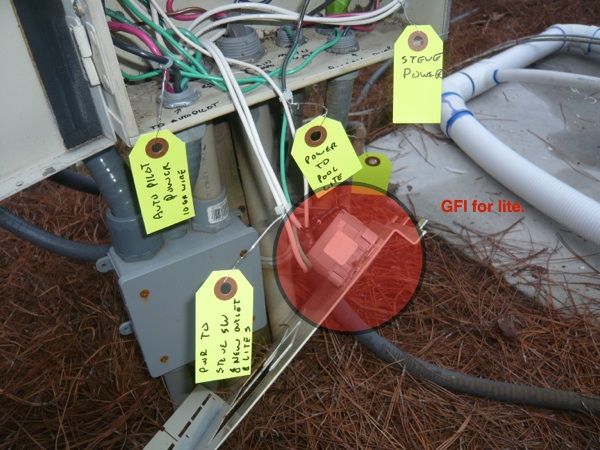
those two B/R wire power the Autopilot SWG.
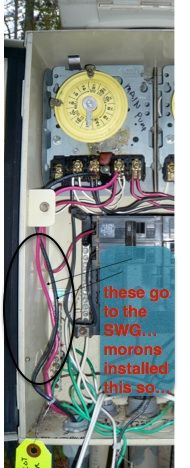
Are you saying I need a 240v GFI at the Box for the Pump(s)?
Good catch. The bus bars are not correct in the drawing ... everything after the breakers looks fine though.
THX ...I'm no electrician...
I just drew what I saw and assumed...
Making the drawing helped my mind wrap around the PFM of the wiring.
Thinking I should replace the old GFI (15 years old) with a new one...?
BTW Steve is the last guy to work on the system so I used the term "Steve Power" on the tags.
I think the new codes require a GFCI breaker on the pumps. That SWG wiring seems odd to me that one leg is always hot and the other is switched.
A GFCI on the pump is required on nearly all new construction these days. In most areas it is not required on existing pools, but still a good idea. This is separate from the GFCI on the pool light, which is required period.
Where I live it is illegal for any pool technician to touch a pool that doesn't have GFCI breakers on everything electrical within 15 feet of the pool. So you can have a non-GFCI pump, but you can't have it serviced.
Where I live it is illegal for any pool technician to touch a pool that doesn't have GFCI breakers on everything electrical within 15 feet of the pool. So you can have a non-GFCI pump, but you can't have it serviced.
I think the new codes require a GFCI breaker on the pumps. That SWG wiring seems odd to me that one leg is always hot and the other is switched.
So are you referring to a 240v GFI for the main pumps?
Yes the SWG wiring is probably odd! It was kinda traumatic....I could not watch... The pool company that I paid a set price for the complete install hired a handyman type with no experience to do the SWG work...wiring/plumbing and it was supervised by the store secretary!!! + those R/B wires look to be HUGE...10ga.?
OK - so I will probable be calling Autopilot for consult or maybe someone could direct me on how to properly perform the SWG electric hookup.
beautiful work.... + I just found the Autopilot case ground/bond terminal was never connected...
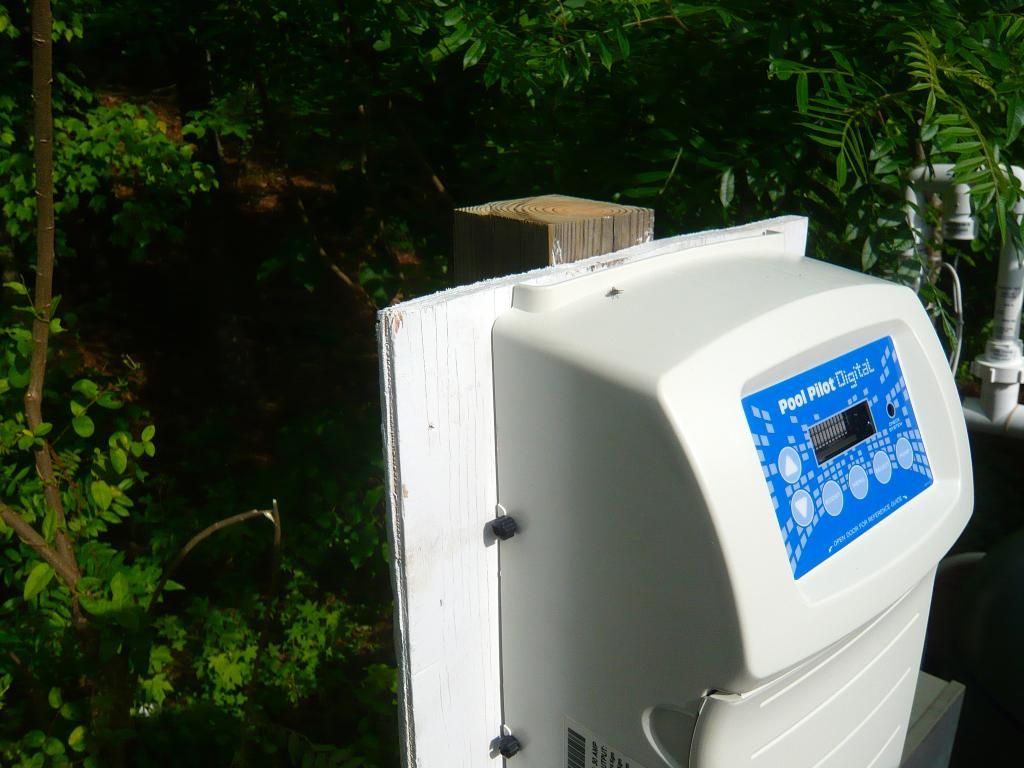
Where I live it is illegal for any pool technician to touch a pool that doesn't have GFCI breakers on everything electrical within 15 feet of the pool. So you can have a non-GFCI pump, but you can't have it serviced.
Where I live I'm beginning to doubt qualified pool technicians exist!
That is what I would have thought. Then the timer will turn on/off both legs of power to the SWG.
More decisions....
I have a new 2 speed pump with a computerized control head with a built in timer.
- a 280 Polaris cleaner with motor.
- An Autopilot DIG 220.
- Intermatic R30404R Timer.
I just spoke with the folks at Autopilot and was informed that I can control the 2 speed motor and the SWG activation with the main Autopilot control head. All I need to do is add a relay. When the 2 speed motor is on low apparently the SWG should not be activated.
What is the best way to control the 2 pumps (filter/cleaner) and the SWG system.
1. could replace the Intermatic with a fully digital timer.
2. Control the cleaner (Polaris) pump with the old mechanical Intermatic and run the filter pump off its own control head. Would have to run wires to the SWG system.
3. Run the SWG and filter pump thru the Autopilot controller .......Polaris????
- - - Updated - - -
2 spd-
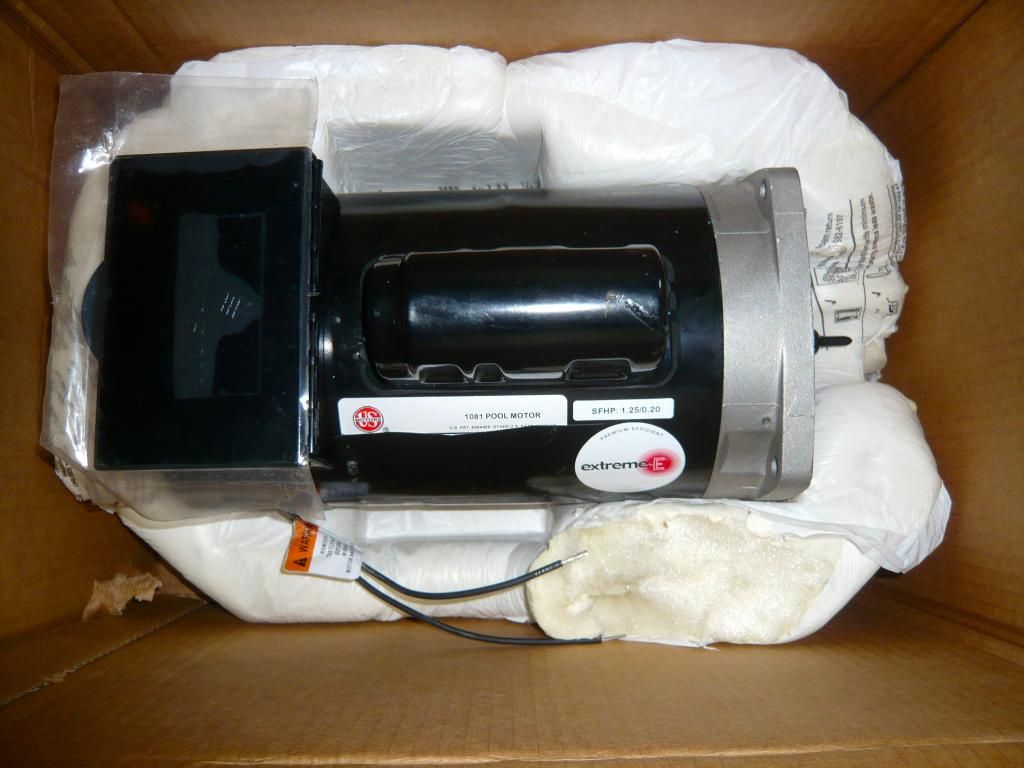
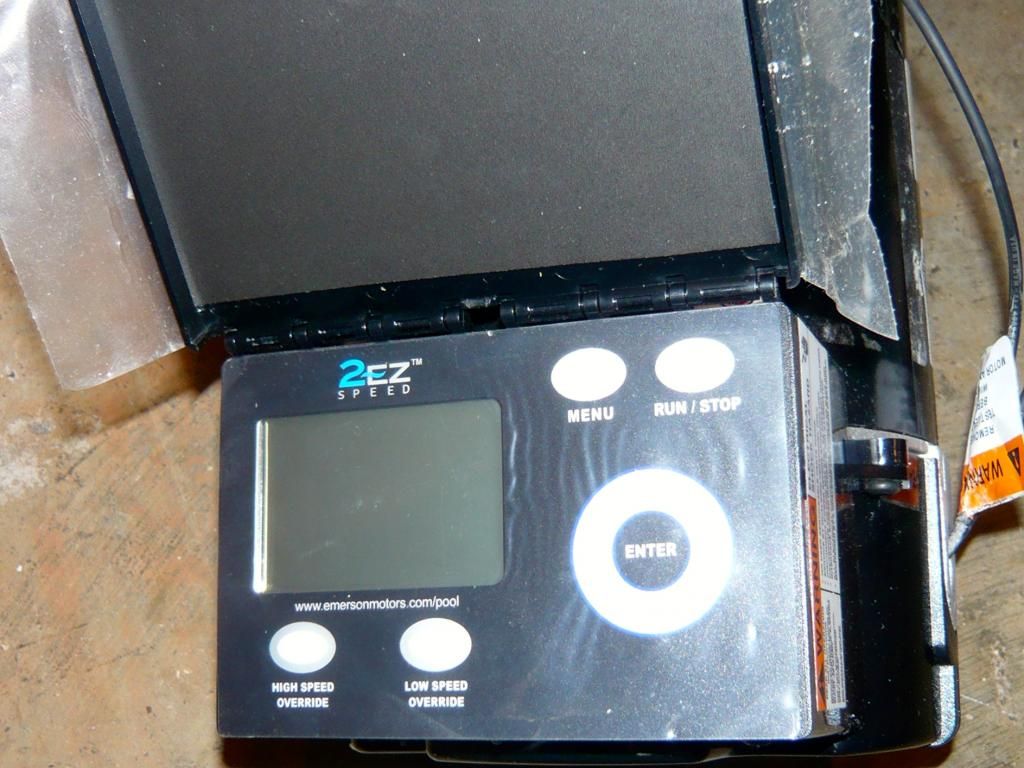
- - - Updated - - -
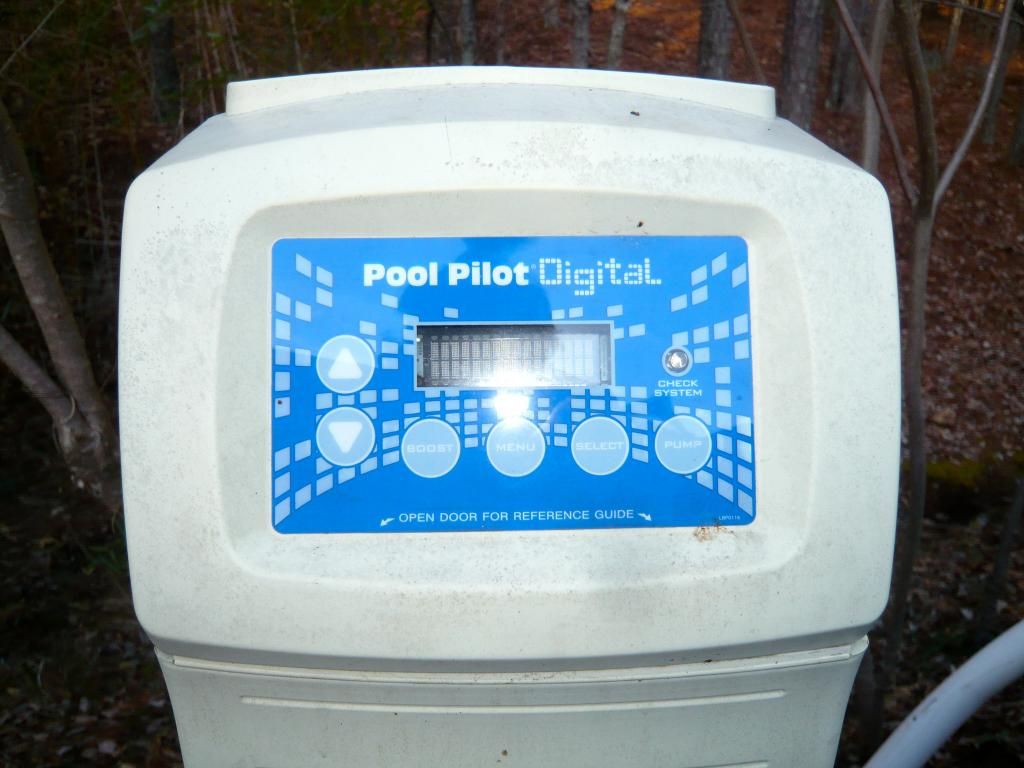
I have a new 2 speed pump with a computerized control head with a built in timer.
- a 280 Polaris cleaner with motor.
- An Autopilot DIG 220.
- Intermatic R30404R Timer.
I just spoke with the folks at Autopilot and was informed that I can control the 2 speed motor and the SWG activation with the main Autopilot control head. All I need to do is add a relay. When the 2 speed motor is on low apparently the SWG should not be activated.
What is the best way to control the 2 pumps (filter/cleaner) and the SWG system.
1. could replace the Intermatic with a fully digital timer.
2. Control the cleaner (Polaris) pump with the old mechanical Intermatic and run the filter pump off its own control head. Would have to run wires to the SWG system.
3. Run the SWG and filter pump thru the Autopilot controller .......Polaris????
- - - Updated - - -
2 spd-


- - - Updated - - -

The AutoPilot is often fine at low speed. It depends on the details of your plumbing, but more often than not it works just fine at low speed.
Using the AutoPilot to control high/low speed might not even be possible with that pump controller, and even if it is possible, it isn't very much use. Generally you want the pump on low speed all of the time and only switch it to high speed when vacuuming or backwashing.
Using the AutoPilot to control high/low speed might not even be possible with that pump controller, and even if it is possible, it isn't very much use. Generally you want the pump on low speed all of the time and only switch it to high speed when vacuuming or backwashing.
Not sure I will be able to help here since I do not know how these systems work.
I will say that the SWG should run fine with the pump on low. Mine does.
I have never seen a 2-speed motor with a digital timer ... this may actually cause you problems in that it may not allow you to wire the low and high speed separately to be controlled by the SWG or another timer. And if you are going to allow some other timer to control it, why have an electronic timer on the motor in the first place?
I will say that the SWG should run fine with the pump on low. Mine does.
I have never seen a 2-speed motor with a digital timer ... this may actually cause you problems in that it may not allow you to wire the low and high speed separately to be controlled by the SWG or another timer. And if you are going to allow some other timer to control it, why have an electronic timer on the motor in the first place?
Not sure I will be able to help here since I do not know how these systems work.
I will say that the SWG should run fine with the pump on low. Mine does.
The Autopilot guy says it needs 15 GPM minimum flow...any idea what low is???
I have never seen a 2-speed motor with a digital timer ... this may actually cause you problems in that it may not allow you to wire the low and high speed separately to be controlled by the SWG or another timer. And if you are going to allow some other timer to control it, why have an electronic timer on the motor in the first place?
I think the dig. controller can be pretty easily bypassed... Well I bought it this way and think I got a pretty good deal but was it necessary looks like maybe not...
I think the Autopilot will work to control the pump at both speeds and possibly freeze guard protection....they seem to provide good fone support.
- - - Updated - - -
Using the AutoPilot to control high/low speed might not even be possible with that pump controller, and even if it is possible, ...so how do you suggest I run the system?
...it isn't very much use.
Generally you want the pump on low speed all of the time and only switch it to high speed when vacuuming or backwashing....wow did not know this. I assumed one would run it on high for at least a few hours a day in the heat of summer...
I appreciate all the input
No idea what your flow rate will be on low speed ... too many factors that I do not know. Just try it and see if the SWG complains. Likely it will be well over 15 GPM.
There are two approaches to wiring everything up that are similar: Use your existing external timer as the master timer, or use the AutoPilot as the master timer. Using the AutoPilot requires that you have the optional (but free) pump control relay, and gives you both freeze protection and failure to prime protection. Using your existing timer has the advantage of being less work to wire up and not requiring the AutoPilot relay.
For high speed/low speed control I would just use the manual switches already on the pump, with it programmed to default to low speed and use high speed as a manual over-ride when you need it.
As mentioned previously, it is very likely you have a good bit more than 15 GPM on low speed, but the only way to be sure is to try it.
For high speed/low speed control I would just use the manual switches already on the pump, with it programmed to default to low speed and use high speed as a manual over-ride when you need it.
As mentioned previously, it is very likely you have a good bit more than 15 GPM on low speed, but the only way to be sure is to try it.
Thread Status
Hello , This thread has been inactive for over 60 days. New postings here are unlikely to be seen or responded to by other members. For better visibility, consider Starting A New Thread.
Similar threads
- Replies
- 1
- Views
- 78
- Replies
- 3
- Views
- 100
- Replies
- 2
- Views
- 155
- Replies
- 4
- Views
- 70


